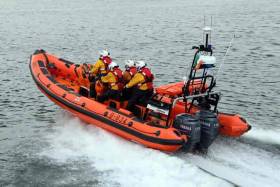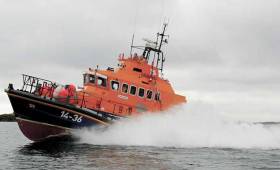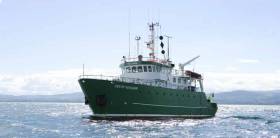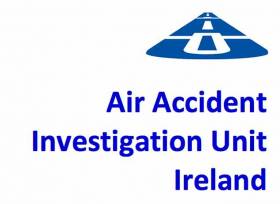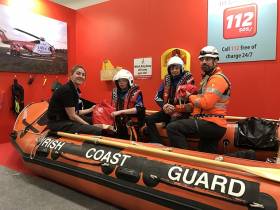Displaying items by tag: Coast Guard
Coast Guard Warns of Heavy Swell on Atlantic Coast
The Coast Guard advises caution to public as Met Éireann warns of heavy swell on Atlantic Coast later on Sunday.
Members of the public have been urged to heed the advice of the Coast Guard as Met Éireann has issued a status yellow wind warning with some very strong west, veering northwest winds expected to affect western and south western coastal counties later Sunday, overnight and into Monday morning with very high seas along the coasts during this period.
The Coast Guard advises the public to be careful on exposed coasts, cliffs and piers, harbour walls and promenades along the Atlantic seaboard particularly at high tide.
Remember to Stay Back, Stay High and Stay Dry.
If you see someone in difficulty in the sea, on the shore dial 999/112 and ask for the Coast Guard.
Overdue Dinghy Sailor's Boat Found Without Anyone on Board
A 90-year-old sailor is feared missing after his empty dinghy was found adrift off the Welsh coast.
Arthur Ray Taylor, known as Archie, was last seen at 9.30am on Saturday, when he left his accommodation to take his dinghy out from Gwbert boat club, Ceredigion, Dyfed-Powys Police said.
A large air and sea search was launched by the Milford Haven Coastguard and RNLI after they were alerted that he had not returned that evening.
A Coastguard spokesman said: "At 5.15pm on Saturday the Coastguard was contacted about an overdue dinghy sailor, aged 90 years old, who had not returned after a trip out on the water during the day and his small boat was found in Cardigan without anyone on board.
"The Coastguard rescue helicopter from Caernarfon, Cardigan, Gwbert and Moylegrove Coastguard Rescue Teams and RNLI lifeboats from Cardigan and Fishguard were all involved in the search along with Dfyd Powys Police.
"After a thorough search of the area, nothing further was found and the search was suspended overnight.
"Milford Haven Coastguard has resumed a search operation in the area this morning."
Police have appealed for anyone who has seen Mr Taylor or knows his whereabouts to contact them.
They described him as 5ft 4ins, of slim build and with grey hair. He was wearing a navy jumper and dark grey waterproof jacket.
Sightings or information can be reported to police by dialling 101 and quoting incident reference 251 of April 15.
Killybegs Coast Guard RIB Takes Dive Boat Under Tow
The volunteer crew of Bundoran RNLI Lifeboat were requested to launch this afternoon to assist a dive boat with 4 persons on board, which had broken down.
The alarm was raised around 1:50pm with Malin Head Coast Guard who immediately requested the launch of the Bundoran Lifeboat and also tasked the Killybegs Coast Guard RIB.
The Bundoran Lifeboat launched at 2pm to the dive boat which was around a mile north of Bullockmore, (west of St John’s Point). The Killybegs Coast Guard rib took the dive boat under tow to Killybegs Harbour with the Bundoran Lifeboat accompanying both vessels.
On returning to the station around 90 minutes later, Volunteer Lifeboat Crew member with Bundoran RNLI Richard Gillespie said ‘the people on board the dive boat were absolutely correct to call the Coast Guard and have ourselves and Killybegs launched. While they were in no immediate danger, the longer they left the call, the more chances there were of something going wrong. We would always encourage boat users to contact the Coast Guard on the first sign of a problem so we can be there to help sooner rather than later.’
Hoax Calls To Rescue Services Put Lives at Risk
The Bangor and Donaghadee RNLI lifeboats launched last week following a ‘Mayday’ call. It was a hoax. Someone decided to make a false call and those two lifeboat crews in Northern Ireland started a search for what was reported to be “a kayaker in trouble… “ Afloat's report of the incident is here.
A rescue helicopter was also called in from Prestwick in Scotland… A search was carried out and the Coast Guard established the call as “an elaborate hoax..”
Bearing in mind the tragedy of Irish Coast Guard helicopter R116 and with the search for two of that crew still continuing, the hoax call-out which resulted in Bangor and Donaghadee lifeboats being launched and the Prestwick helicopter called in from Scotland, was shocking…. So on my Podcast this week I highlight the serious dangers caused by hoax call-outs.
Listen to the Podcast here and the response of the RNLI.
Fishing Boats Join Search For #Rescue116 Crew in Largest Open Water Search in History of the State
The Coast Guard Rescue Coordination Centre in Malin is managing the surface search for the two missing crewmen of Rescue 116 this morning with a reported large number of fishing vessels that have offered their services.
The search is being desrcibed as the 'Largest open water search in the history of the Irish State'. Calm conditions off the West Coast have enabled searchers to get underway as planned.
No trace of Paul Ormsby or Ciarán Smith was found when the wreck of the Sikorsky S-92 helicopter was lifted from the sea bed off Black Rock in Co Mayo last weekend, as previously reported on Afloat.ie.
While underwater operations are ongoing, a fleet of fishing vessels from Killybegs this week are sweeping the Atlantic seaboard at first light this morning for any sign of the missing coastguard airmen.
More on this in our post yesterday here
Search Continues for Missing Crew of R116
Remote Operations Vehicle (ROV) operations, conducted by Marine Institute specialists on-board the Granuaile in conjunction with An Garda Síochána and the Air Accident Investigation Unit continued overnight and are ongoing. Wind has freshened overnight, which may constrain certain elements of the proposed search until Sunday, but conditions remain favourable for time being. Air, surface and shoreline searches are ongoing today, supported by Coast Guard, RNLI and Civil Defence volunteers. The Shannon based Coast Guard helicopter will conduct aerial searches later today. The Air Corps are also supporting the search.
Also the Coast Guard wishes to request all mariners, particularly those not participating on Saturday 8th April, to continue to keep a good lookout for any material associated with R116 and report any sightings to Malin Head Coast Guard Co-ordination Centre.
The Maritime & Coastguard Agency’s new Head of Maritime Operations, Julie-Anne Wood, has made history by becoming the first woman to achieve this rank in the history of Her Majesty’s Coastguard.
The role of Head of Maritime Operations heads up the National Maritime Operations Centre in Fareham and the 10 Coastguard Operations Centres that co-ordinate search and rescue around the UK coast. It is one of the most senior roles in HM Coastguard, part of the Maritime & Coastguard Agency, and up until now, the role has always been held by a man.
Julie-Anne Wood began her Coastguard career in the Welsh coastal town of Milford Haven in 1999 as a part-time Coastguard Watch Assistant. Before that, she ran her own business providing safety training to fishermen and merchant seamen in Wales. An opportunity for a permanent Coastguard Watch Assistant came up and in Julie-Anne’s words, she ‘never looked back’.
Over the next nine years, Julie-Anne progressed through the ranks to Watch Officer, Watch Manager and then Rescue Co-ordination Centre Manager in 2008. In 2011, her career changed direction, where she fulfilled her long-term goal to become a Coastguard Technical Trainer within the HR team. In 2013, she became head of Technical Training and Standards and in 2014 she temporarily covered the role of Head of Maritime Operations. In January 2017, she was appointed to the position permanently.
Julie-Anne says she didn’t set out to make HM Coastguard history. It was just a natural advancement of her career. ‘It’s a huge responsibility and a position that I’m very honoured to hold. What may have once been a male-dominated industry is very different these days. The Maritime & Coastguard Agency has incorporated women in everything they do. In my experience, there have been no restrictions. I have never allowed my gender to get in the way of my career – that’s one of the great things about HM Coastguard – the only limits on women are those that are imposed by themselves.
‘I am fortunate to be surrounded by an extraordinary team of strong women and men who are driven, talented and deliver an incredible service 24 hours a day.'
Despite her success, Julie-Anne has said that her proudest moments are still engrained in bringing people home to their families. ‘Every rescue is different, but the feeling you get when we’ve rescued someone in their darkest hours still makes a huge impression on me emotionally. There is no better feeling than seeing families reunited and know that you’ve played a part in that.’
The AAIU in consultation with An Garda Síochána, the Navy, the Coast Guard, the GSI and the Marine Institute wish to advise that following initial Remote Operated Vehicle (ROV) operations the wreckage of R116 has been positively located on the sea bed on the Eastern side of Black Rock, at a depth of approx. 40m.
Operations are continuing but are weather dependent.
AAIU Statement on Investigation into the Loss of R116
The AAIU wishes to extend its sincere sympathies to the families and friends of the crew of R116.
The Chief Inspector of Air Accidents, Mr. Jurgen Whyte, in consultation with the appointed Investigator-in-Charge, Mr. Paul Farrell, wishes to make the following statement.
An AAIU investigation into the circumstances of the loss of R116 is underway. As with all AAIU investigations, this Investigation will be evidence based.
The Investigation has been working with the Garda Síochána, Coast Guard, Irish Air Corps, the Irish Marine Institute, and many local persons and agencies with the primary objective of locating and recovering the missing crew members.
In addition, the AAIU is anxious to recover and examine as much wreckage as possible, and in particular to recover the combined voice and flight data recorder (“black box”). The AAIU, in accordance with international convention, has an Accredited Representative from the US National Transportation Safety Board (as state of design and manufacture); that representative has advisers from the US Federal Aviation Administration and the aircraft manufacturer. The AAIU has also received assistance, support and advice from the UK Air Accidents Investigation Branch two of whose inspectors attended Blacksod.
A significant amount of wreckage has been recovered from the sea and this has been logged and will be brought to the AAIU wreckage facility in Gormanston, Co Meath, for detailed examination.
Furthermore, the AAIU has visited Black Rock Light House, on the approaches to Blacksod bay, which is close to the last recorded position of the helicopter. Some helicopter wreckage has been recovered from the general area of Black Rock Light House. This wreckage is primarily from the tail area of the helicopter. At this early stage in the investigation it is not possible to be definitive about the exact nature of damage to the recovered wreckage or indeed the circumstances of the accident. However, there appears to be marks on some of the recovered wreckage which are consistent with the tail of the aircraft contacting rocky surfaces on the Western end of Blackrock.
The Investigation has not yet definitively identified the initial point of impact.
Equipment aboard surface search vessels has detected a signal which is believed to be from the underwater locator beacon attached to the aircraft’s “Black Box”. This signal points toward an area which will be the focus of further, multi-agency investigation activities at the earliest opportunity, subject to weather.
Coast Guard 'Emergency Challenge' At Young Scientist Exhibition
The Irish Coast Guard is well represented at this week's BT Young Scientist Exhibition where 60,000 visitors are expected to attend.
The six Coast Guard stations in attendance at the RDS, Dublin are distributing wristbands, pencils and competition flyers as well as staging today's 'Emergency Challenge' competition.




























